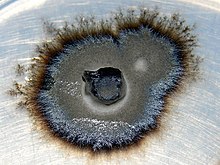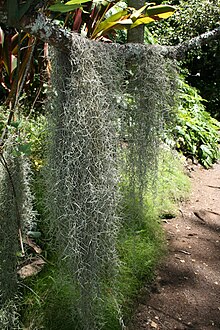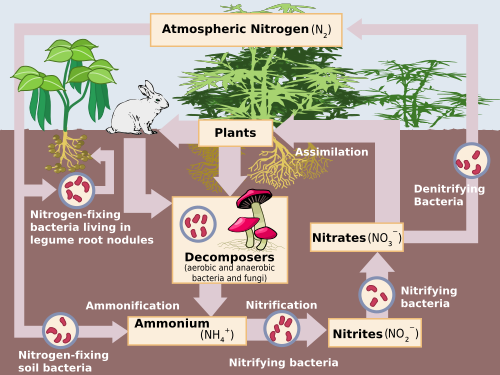Ecology
Ecology is the study of how living organisms interact with their environment in different ways e.g.: when we respire, we react with our atmosphere by exchanging gases with it. When particular organisms like fungi decompose the dead bodies of living beings then they interact with the soil and provide it with the necessary nutrients which are needed by plants, so these nutrients are recycled.
So the interaction between the living organisms and their environment is so necessary for the recycling of nutrients & hence the existence of life on the planet Earth. These interactions are the conditions for life on this planet. Many living beings interact with the nonliving environments as well as with their living environment. For example, lions feed on deer and their lives depend upon deer. But if the lion goes extinct, then there would be no other factor to control the population of deer and the overcrowdedness of the deer will be dangerous for the plants. So all organisms interact with each other directly or indirectly and form a network, which we call a community or ecosystem. These communities also interact with each other and form a large community i.e. a biosphere. Every organism has its own importance in an ecosystem that can't be ignored.

- Ecological Succession: The change in a community after a disaster.
- Primary Succession: The change that takes place in a community when no soil is present.
- Pioneer Species: Liches and moss (first species to populate an area).
- Secondary Succession: The change that takes place in a community when soil is present.
- Difference between primary succession and secondary succession
- Primary succession starts without soil while secondary succession starts with soil.
- Pioneer species exist only in primary succession with species like lichens and moss.
- Secondary succession starts with weed.
- Climax Community: A community that is in a state of equilibrium (stable).
Limiting Factors
[edit | edit source]A population's size can be affected by a number of different things called limiting factors.
| Limiting Factor | How does it affect a population? |
|---|---|
| Predation | One organism consumes another organism. |
| Parasitism | One organism lives off flesh/body fluids of other organisms. |
| Competition | Two organisms compete for a food source. |
| Drought | Lack of water. |
| Disease | A disease that can kill a whole population. |
| Climate | Weather and climate affect the size of a population. |
| Pollution/Human Disturbances | Human activities, such as pollution and deforestation. |
- Density-dependent limiting factors - Factors that limit a population only when it reaches a certain density (number of organisms in a given area). Examples are predation, parasitism, competition, and disease.
- Density-independent limiting factors - Factors that limit a population regardless of density. Examples are pollution/human activity, water availability, and climate.
Population Growth
[edit | edit source]A population's growth changes over time. The change in growth is known as a population's growth rate. What are four things that affect a population's growth rate?
- Number of Births
- Number of Deaths
- Immigration
- Emmigration
Exponential Growth Curve
[edit | edit source]
X-axis: Time
- Exponential growth occurs when the rate of growth in each new generation is a multiple of the previous generation.
- What is an example of an organism that goes through exponential growth? Bacteria.
Carrying Capacity/S-Shaped Curves
[edit | edit source]
The carrying capacity is the number of organisms that can be supported by the environmental resources in an ecosystem. A carrying capacity graph illustrates that the environment can only produce so much food and shelter for a population before the population reaches an equilibrium--the same number of births each year equal the same number of deaths. Another term for carrying capacity is S-shaped curve.
Predation Curve
[edit | edit source]
A predation curve shows the relationship between a predator and a prey and how one affects the other one. An example is the lynx and the rabbit.
Boom-Bust Curve
[edit | edit source]A boom and bust curve represent exponential growth followed by a sudden collapse. An example is an insect population's cycle through the year. They are abundant in the summer months but are limited in the fall and winter months.
Population Interaction
[edit | edit source]| Interaction | Definition | Example |
|---|---|---|
| Competition | Competing with each other for the same resources | Plants competing for water and light |
| Predation | One organism hunts and consumes another | Fox eating a rabbit |
| Parasitism | One organism feeds off of the fluids/tissue of another | Tapeworm in an intestine |
| Mutualism | When the organisms fill a need for each life | Remora fish eating parasites off of a shark's skin |
| Commensalism | When one organism benefits from a 2nd organism (not harmed) | Barnacle on a whale |
- Symbiosis: Relationship in which 2 species live closely together.
Parasitism, mutualism, and commensalism are all forms of symbiosis relationships.



Nitrogen Cycle
[edit | edit source]
- See also w:Nitrogen Cycle
Nitrogen is an important gas in our lives--serving 78% of the gases in our atmosphere. Therefore, the nitrogen cycle serves a very crucial factor in our normal well-being. But how does this work?
Unlike carbon, nitrogen cannot be (directly) fixed [from the air] by complex organisms, such as plants--nitrogen is fixed by prokaryotes (nitrogen-fixing bacteria).
Section 1: Nitrogen Cycle
[edit | edit source]The nitrogen-fixing bacteria take N2 and convert it into a more usable form for complex organisms (plants, humans, etc.)--Ammonia (NH3).
Ammonia is vital for plants and other complex organisms [in order to live]. By [us] eating the plants, we get a share of the mighty nitrogen that we need in our lives.
Section 2: Nitrogen Cycle
[edit | edit source]For example, when a squirrel dies, different types of bacteria decompose the dead squirrel in order to receive nutrition. As these bacteria are decomposing (digesting) the dead squirrel's body, many different things can happen:
- Bacteria takes nitrogen and converts them to nitrates and/or nitrites.
- Bacteria takes nitrogen back to ammonia.
- Bacteria converts the nitrates and nitrites into molecular nitrogen, in which that [molecular nitrogen] is released back into the atmosphere.
Carbon Cycle
[edit | edit source]
- See also: w:Carbon Cycle
Carbon is an element of our atmosphere that is very vital to our normal well-being. Carbon can be found in glucose, ATP, amino acids and other biological substances (organic macromolecules)--including ourselves (our mass is 18-19% carbon). But carbon doesn't just randomly come into our atmosphere every now and there--but rather, they go through an important, staged cycle that is neatly played through count-less amount of times.
Section 1: Carbon Cycle
[edit | edit source]Carbon in our atmosphere (mainly in the form of molecular carbon dioxide) is "fixed" by plants [with the aid of sunlight] when plants take the molecular carbon dioxide and "fix" the carbon [in it] and then integrate different molecules [from it] into themselves [plants]. These different molecules being integrated into the plant help the plants with things such as energy and structure.
When we, humans (for example), eat these plants, we get the carbon in our bodies from the plants to help our bodies out. Then, some time later, we release CO2 back into the air [atmosphere].
Basically, you can see the cycle that is being depicted here. This is one way of how the carbon cycle operates.
Section 2: Carbon Cycle
[edit | edit source]
It is possible for molecular carbon dioxide to be absorbed into the ocean. Carbon dioxide could be absorbed by living things [in order] to use the carbon that is found in carbon dioxide. As these living things break down/decompose over time, the carbon stored in these living things (and remember, this can be me and you!) will be released back into the atmosphere as carbon dioxide.
Relationships
[edit | edit source]- Mutualism [Code: + +] is when both organisms are being benefited.
- The ant keeps predators away from the acacia tree. The acacia provides shelter and food for the ant.
- Commensalism [Code: + 0] is when one organism is being benefited, while the other organism is not affected.
- The orchid lives on a tree branch without harming the tree, nor helping the tree.
- Parasitism [Code: + -] is when one organism is being benefited, while the other organism is being harmed.
- The tapeworm lives in the dog's intestines and absorbs the nutrients from the dog's food.
- Competition [Code: No code] is when two organisms battle for something, such as food.
- The cow eats grass. The sheep eat grass in the same field.
